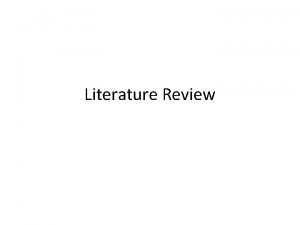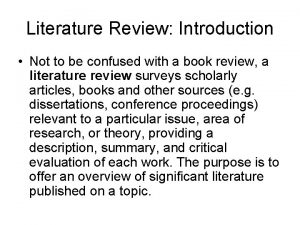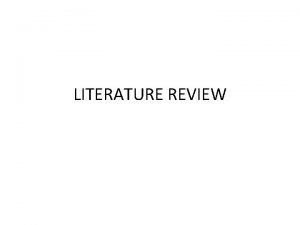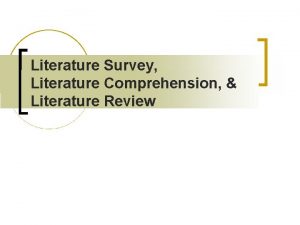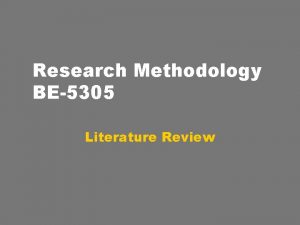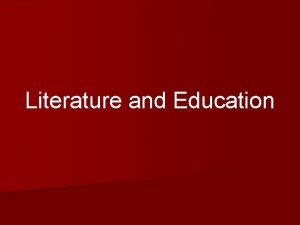Literature Review Introduction to the literature review 1

![Introduction to the literature review [1] The introduction must clearly highlight WHAT you will Introduction to the literature review [1] The introduction must clearly highlight WHAT you will](https://slidetodoc.com/presentation_image_h/97d617896463e46356aafef744e73077/image-2.jpg)
![Linking Multiple sources [1] Look at the first sentence. The keyword is MOTIVATION which Linking Multiple sources [1] Look at the first sentence. The keyword is MOTIVATION which](https://slidetodoc.com/presentation_image_h/97d617896463e46356aafef744e73077/image-3.jpg)

![Poor Literature Review [1] This shows no critical thinking, no link between sources and Poor Literature Review [1] This shows no critical thinking, no link between sources and](https://slidetodoc.com/presentation_image_h/97d617896463e46356aafef744e73077/image-5.jpg)
![Keywords [1] Suggest (that) Argue (that) Contend(s) Outline Focus on Define(s) Conclude(s) (that) State Keywords [1] Suggest (that) Argue (that) Contend(s) Outline Focus on Define(s) Conclude(s) (that) State](https://slidetodoc.com/presentation_image_h/97d617896463e46356aafef744e73077/image-6.jpg)





![REFERENCES [1]https: //www. dlsweb. rmit. edu. au/lsu/content/2_assessmenttasks/assess_tuts/lit_review_LL/writing. html [2]https: //owl. english. purdue. edu/owl/resource/619/03/ [3]https: REFERENCES [1]https: //www. dlsweb. rmit. edu. au/lsu/content/2_assessmenttasks/assess_tuts/lit_review_LL/writing. html [2]https: //owl. english. purdue. edu/owl/resource/619/03/ [3]https:](https://slidetodoc.com/presentation_image_h/97d617896463e46356aafef744e73077/image-12.jpg)
- Slides: 12

Literature Review
![Introduction to the literature review 1 The introduction must clearly highlight WHAT you will Introduction to the literature review [1] The introduction must clearly highlight WHAT you will](https://slidetodoc.com/presentation_image_h/97d617896463e46356aafef744e73077/image-2.jpg)
Introduction to the literature review [1] The introduction must clearly highlight WHAT you will cover in this review. This is particularly important in a large topic area. In this example, the focus is on self-motivation
![Linking Multiple sources 1 Look at the first sentence The keyword is MOTIVATION which Linking Multiple sources [1] Look at the first sentence. The keyword is MOTIVATION which](https://slidetodoc.com/presentation_image_h/97d617896463e46356aafef744e73077/image-3.jpg)
Linking Multiple sources [1] Look at the first sentence. The keyword is MOTIVATION which associate with the problem statement highlighted in the first slide. As you can observed, there is a comparison (keyword: similarly, however, supported) between references.

Again more comparison (keyword: supported) But, you can also see that now, you can add your own opinion which is based on your objectives/problem statement.
![Poor Literature Review 1 This shows no critical thinking no link between sources and Poor Literature Review [1] This shows no critical thinking, no link between sources and](https://slidetodoc.com/presentation_image_h/97d617896463e46356aafef744e73077/image-5.jpg)
Poor Literature Review [1] This shows no critical thinking, no link between sources and no evaluation
![Keywords 1 Suggest that Argue that Contends Outline Focus on Defines Concludes that State Keywords [1] Suggest (that) Argue (that) Contend(s) Outline Focus on Define(s) Conclude(s) (that) State](https://slidetodoc.com/presentation_image_h/97d617896463e46356aafef744e73077/image-6.jpg)
Keywords [1] Suggest (that) Argue (that) Contend(s) Outline Focus on Define(s) Conclude(s) (that) State Maintains (that) Found (that) Promote(s) Establish(ed) (by) Asserts (that) Show(s) Claim(s) (that) Report(s) Mention(s) Address Recent studies outlined by Leonard et al (1999) suggest that personality and disposition play an equally important role in motivation. Leonard et al (1999) argue that there are three elements of self perception. Mullens (1994) contends that motivation to work well is usually related to job satisfaction. Recent studies outlined by Mullins (1994) suggest that personality and disposition play an equally important role in motivation. The early theories of Maslow and Mc. Gregor (Robbins et al, 1998) focused on personal needs and wants as the basis for motivation. Eunson (1987, p. 67) defines motivation as 'what is important to you'. Reviewing the results of the case study, Taylor (1980) concludes that theories of job enrichment and employee motivation do work. He further states that there is an increasing importance on the role of autonomy and self regulation of tasks in increasing motivation. Mullins (1994) maintains that job enrichment came from Herzber's two factor theory. Mullins (1994) found that there is an increasing importance on the role of autonomy and self regulation of tasks in improving motivation. This promotes the idea that tension and stress are important external sources of motivation, which can be eliminated by completing certain tasks. As established by Csikszentmihalyi (Yair 2000, p. 2) 'the more students feel in command of their learning, the more they fulfil their learning potential'. Locke's Goal Setting Theory asserts that setting specific goals tends to encourage work motivation (Robbins et al, 1998). Various theories of motivation show employers that there are many factors that influence employees work performance. Hackman and Oldham (1975) claim that people with enriched jobs, and high scores on the Job Diagnostic Survey, experienced more satisfaction and motivation. Mullins (1994) reports on four content theories of motivation. Mullins (1994) mentions two common general criticisms of Herzberg's theory. Redesigning jobs so that responsibility moved from supervisors to the workers, was an attempt to address the issues of job satisfaction (Mullins, 1994).

Paraphrasing convey the information from the original source in your paper by rephrasing it in your own words – the new form must still reflects the original text accurately. But remember: You still have to cite the reference. 6 Steps to Effective Paraphrasing [2] 1. Reread the original passage until you understand its full meaning. 2. Set the original aside, and write your paraphrase on a note card. 3. Jot down a few words below your paraphrase to remind you later how you envision using this material. At the top of the note card, write a key word or phrase to indicate the subject of your paraphrase. 4. Check your rendition with the original to make sure that your version accurately expresses all the essential information in a new form. 5. Use quotation marks to identify any unique term or phraseology you have borrowed exactly from the source. 6. Record the source (including the page) on your note card so that you can credit it easily if you decide to incorporate the material into your paper.

Example (Short Sentences) ORIGINAL: The task of the engineer is to produce the correct product at the correct cost at the correct time. (Fox , 1977) PARAPHRASE: Fox (1977) states that engineers need to come up with the right products at the right time and at a reasonable price (p. 30). ORIGINAL: If a product misses its window of opportunity, the manufacturer can lose up to 33% of the life cycle profits. (taken from page 45) PARAPHRASE: Fox (1977) claims that 33% of profits can be lost if a product is not marketed correctly (p. 45). ORIGINAL: Lost sales are never made up as changes in the market place and in competitors’ equipment mean that any product has a finite life (taken from page 48). PARAPHRASE: One expert points out that products only have a limited life due to market changes and competition. As a result lost sales cannot be regained (Fox, 1977, p. 48).

Example (Long Sentence) ORIGINAL: Students frequently overuse direct quotation in taking notes, and as a result they overuse quotations in the final research paper. Probably only about 10% of your final manuscript should appear as directly quoted matter. Therefore, you should strive to limit the amount of exact transcribing of source materials while taking notes. (Lester, James D. Writing Research Papers. 2 nd ed. (1976): 46 -47. ) PARAPHRASING: In research papers students often quote excessively, failing to keep quoted material down to a desirable level. Since the problem usually originates during note taking, it is essential to minimize the material recorded verbatim (Lester 46 -47).

ORIGINAL: Students frequently overuse direct quotation in taking notes, and as a result they overuse quotations in the final research paper. Probably only about 10% of your final manuscript should appear as directly quoted matter. Therefore, you should strive to limit the amount of exact transcribing of source materials while taking notes. (Lester, James D. Writing Research Papers. 2 nd ed. (1976): 46 -47. ) PLAGARISM Students often use too many direct quotations when they take notes, resulting in too many of them in the final research paper. In fact, probably only about 10% of the final copy should consist of directly quoted material. So it is important to limit the amount of source material copied while taking notes. Why? Firstly, the reference is NOT CITED in the text. Then, too many exact words are used. There are phrases which have been taken directly from the original, and while some effort has been made to change the order of some sentences or some words, the writer hasn't done this enough. The ideas are presented in the same order and are constructed in virtually the same way. When you paraphrase, you must ensure that you change the sentence structure and the words used. This doesn't mean just swapping a few words around. You must demonstrate your own understanding of a text in your own words. This understanding demonstrates your gained knowledge. [3]

ORIGINAL: An astonishing 64 percent of these engineers' overall work time is spent on some form of communication. This result has far-reaching implications for employers and engineering schools. Employers need to know that 64 percent of the salaries they expend on newly graduated engineers pay for their communication skills, not their engineering competencies. Clearly, technical ideas and results are not useful until and unless they are communicated and discussed. Therefore, employers are justified in demanding graduates who are thoroughly trained in communicating technical information. Engineering schools need to prepare all their students for the real-world communication demands their graduates will face. Just providing an outstanding technical education is no longer sufficient, as many respondents observed. INADEQUATE PARAPHRASING: Sageev and Romanowski (2001) found that engineers spend 'an astonishing 64 percent' of their work time engaged in 'real-world communication'. They argue that 'this result has far-reaching implications' for employers and that 'employers are justified in demanding' that engineering schools will adequately prepare their students by training them 'in communicating technical information'. Why? This paraphrase is not plagiarized but the quotations are used inappropriately. If you use lots of short quotations, that signifies to the reader that you are not capable of understanding the material enough to put it in your own words. Therefore, it is important to rewrite the quotations in your own words when possible. You should only use a quotation if it is important to preserve the original wording, or if paraphrasing it makes the message less effective [3].
![REFERENCES 1https www dlsweb rmit edu aulsucontent2assessmenttasksassesstutslitreviewLLwriting html 2https owl english purdue eduowlresource61903 3https REFERENCES [1]https: //www. dlsweb. rmit. edu. au/lsu/content/2_assessmenttasks/assess_tuts/lit_review_LL/writing. html [2]https: //owl. english. purdue. edu/owl/resource/619/03/ [3]https:](https://slidetodoc.com/presentation_image_h/97d617896463e46356aafef744e73077/image-12.jpg)
REFERENCES [1]https: //www. dlsweb. rmit. edu. au/lsu/content/2_assessmenttasks/assess_tuts/lit_review_LL/writing. html [2]https: //owl. english. purdue. edu/owl/resource/619/03/ [3]https: //airport. unimelb. edu. au/engineering/sources/paraphrasing. php
 Literature review introduction example
Literature review introduction example Literature review introduction
Literature review introduction Introduction of review of literature
Introduction of review of literature Hát kết hợp bộ gõ cơ thể
Hát kết hợp bộ gõ cơ thể Slidetodoc
Slidetodoc Bổ thể
Bổ thể Tỉ lệ cơ thể trẻ em
Tỉ lệ cơ thể trẻ em Gấu đi như thế nào
Gấu đi như thế nào Tư thế worms-breton
Tư thế worms-breton Chúa yêu trần thế
Chúa yêu trần thế Các môn thể thao bắt đầu bằng tiếng nhảy
Các môn thể thao bắt đầu bằng tiếng nhảy Thế nào là hệ số cao nhất
Thế nào là hệ số cao nhất Các châu lục và đại dương trên thế giới
Các châu lục và đại dương trên thế giới
